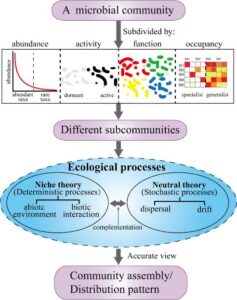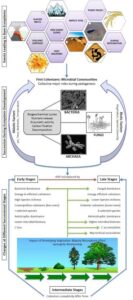Back to: MICROBIOLOGY 400 LEVEL
Welcome to class!
Hi superstar! It’s so good to have you here again. Your dedication to learning is something to be truly proud of. Today, we’re going to talk about a topic that shows how communities of microbes grow and change over time—Microbial Succession and Community Dynamics. Just like people move, grow, and change in communities like Lagos or Enugu, microbes also go through changes in their “neighbourhoods.” Let’s find out how!
Microbial Succession And Community Dynamics
What is Microbial Succession?
Microbial succession is the natural and orderly process through which microbial communities change over time in a particular environment. It’s just like watching a new estate develop—from empty land to a busy neighbourhood filled with shops, schools, and houses.

In the beginning, only a few types of microbes can survive the tough conditions. But as time goes on, more species move in, the environment becomes richer, and a stable, balanced microbial community is formed.
There are two main types:
Primary succession – when microbes colonise a brand-new, lifeless environment like volcanic ash or a sterile hospital surface.
Secondary succession – when microbes return to an area that was disturbed or damaged, like a farmland after bush burning or an oil-spilled site in the Niger Delta.
What is Community Dynamics?
Community dynamics refers to the interactions and changes in the microbial community over time. It involves how microbes compete, cooperate, or replace one another based on environmental factors like nutrients, pH, temperature, or human activity.
This is just like in a real human community: some people move in, others leave, and the way people interact changes as the town grows.
Stages of Microbial Succession
Initial Colonisation
Only a few hardy microbes—often bacteria—can survive in a new or harsh environment. These are known as pioneer species.
Establishment and Growth
As conditions improve (more nutrients, better pH, etc.), other microbes like fungi and actinomycetes start to grow and form new relationships.
Mature Community Formation
Eventually, a stable and diverse microbial community forms. This community performs complex functions like nutrient recycling, organic matter breakdown, and disease resistance.
Disturbance and Renewal
If something disrupts the environment (e.g., fire, pollution, antibiotics), some microbes die off, and the succession process starts again—usually faster than before.
Examples in Nigerian Context
After slash-and-burn farming, microbial succession begins in the soil as bacteria start breaking down ash and dead material, making way for fungi and other microbes.

In a compost heap, bacteria dominate first, then fungi take over as the pile heats up, eventually forming a rich, balanced microbial mix that enriches the soil.
After an oil spill, hydrocarbon-eating bacteria such as Pseudomonas begin the clean-up, followed by other microbes that restore the soil over time.
Summary
- Microbial succession is the step-by-step change in microbial communities over time.
- It occurs in response to environmental changes or disturbances.
- Primary succession starts in lifeless areas; secondary succession happens after disturbance.
- Community dynamics refers to how microbes interact, compete, and adapt in their environments.
- Pioneer species like bacteria are first to colonise a new area.
- Over time, other microbes join, creating a stable community.
- Soil, compost heaps, and polluted sites in Nigeria all show microbial succession.
- Disturbances can restart succession, often leading to stronger communities.
- Microbial succession helps in recycling nutrients, cleaning environments, and supporting life.
Evaluation
- What is the difference between primary and secondary microbial succession?
- Describe the stages involved in microbial succession.
- Give one example of microbial succession that can occur in an agricultural setting.
Learning how microbes grow, change, and help rebuild environments gives you the power to understand how nature heals itself. Keep showing up with that amazing curiosity—Afrilearn is right here with you, every step of the way. See you in the next class!
